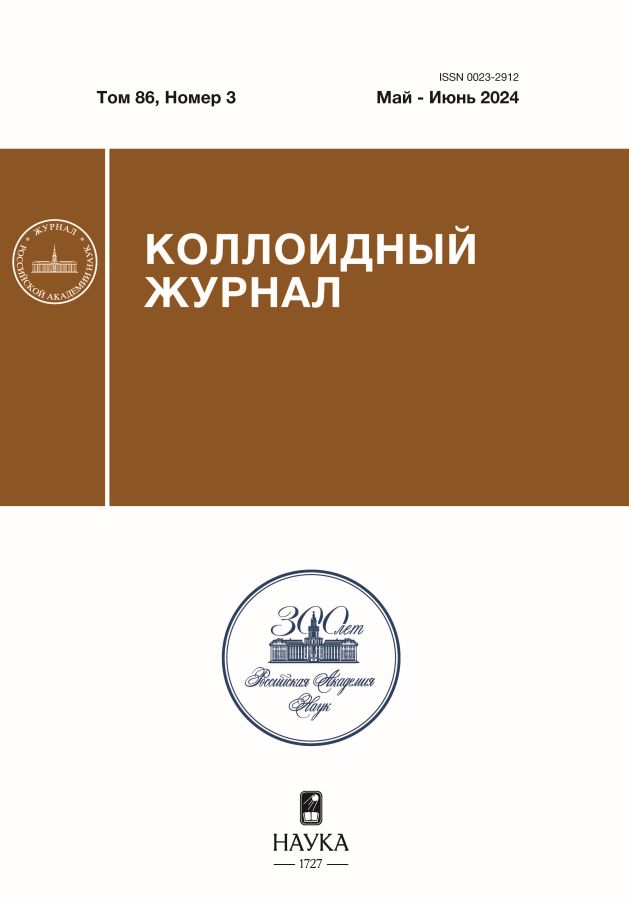Оценка толщины фронта плавления льда, основанная на исследовании кинетики таяния ледяных шаров в воздухе
- Autores: Степанов И.С.1, Будаева Л.И.1, Степанов С.В.1
-
Afiliações:
- НИЦ “Курчатовский институт” – ККТЭФ
- Edição: Volume 86, Nº 3 (2024)
- Páginas: 397-404
- Seção: Articles
- ##submission.dateSubmitted##: 27.02.2025
- ##submission.datePublished##: 15.06.2024
- URL: https://cijournal.ru/0023-2912/article/view/670929
- DOI: https://doi.org/10.31857/S0023291224030089
- EDN: https://elibrary.ru/BMCQXD
- ID: 670929
Citar
Texto integral
Resumo
На основе измерений кинетики накопления талой воды при плавлении ледяных шаров разного размера при комнатной температуре (≈22°C), а также с учетом измерений температуры как на поверхности шаров, так и внутри них, удалось оценить толщину фронта плавления льда. Входящий тепловой поток поглощается льдом внутри слоя, который мы называем фронтом плавления, в виде скрытой теплоты плавления. Для описания кинетики таяния ледяных шаров была построена модель этого процесса. Предполагалось, что подвод тепла происходит через всю поверхность шара, причем его площадь уменьшается в процессе плавления. Измерения температуры на поверхности ледяных шаров и температуры внутри них дали ~0.4 и 0°C соответственно. Учтены поправки, связанные с испарением воды. Подгонка экспериментальных данных с использованием предложенной модели позволила оценить толщину фронта плавления льда при комнатной температуре. Она оказалась равной примерно 3.2–3.6 мм.
Palavras-chave
Texto integral
Sobre autores
И. Степанов
НИЦ “Курчатовский институт” – ККТЭФ
Autor responsável pela correspondência
Email: stepanov@itep.ru
Rússia, 123182, Москва, пл. Академика Курчатова, д. 1
Л. Будаева
НИЦ “Курчатовский институт” – ККТЭФ
Email: stepanov@itep.ru
Rússia, 123182, Москва, пл. Академика Курчатова, д. 1
С. Степанов
НИЦ “Курчатовский институт” – ККТЭФ
Email: stepanov@itep.ru
Rússia, 123182, Москва, пл. Академика Курчатова, д. 1
Bibliografia
- Маэно Н. Наука о льде. Мир, 1988. 231 c.
- Уббелоде А. Плавление и кристаллическая структура. Мир, 1969. 420 c.
- Mazur P. Principals of Cryobiology in “Life in the Frozen State” Eds. Fuller B.J., Lane N., Benson E.E. CRC Press, Boca Raton, 2004. https://doi.org/10.1201/9780203647073
- Тихонов A.H., Самарский А.А. Уравнения математической физики. Изд-во: МГУ, 1999.
- Bartels-Rausch Т. Ten things we need to know about ice and snow // Nature. 2013. V. 494. № 7435. P. 27–29. https://doi.org/10.1038/494027a
- Dash J.G., Rempel A.W., Wettlaufer J.S. The physics of premelted ice and its geophysical consequences // Rev. Mod. Phys. 2006. V. 78. № 3. P. 695–741. https://doi.org/10.1103/RevModPhys.78.695
- Fitzner М., Sosso G.C., Cox S.J., Michaelides A. Ice is born in low-mobility regions of supercooled liquid water // PNAS. 2019. V. 116. № 6. P. 2009–2014. https://doi.org/10.1073/pnas.181713511
- Wei X., Xiao S., Ni J. Studies of ice melting using molecular dynamics // Molecular Simulation. 2010. V. 36. № 11. P. 823–830. https://doi.org/10.1080/08927021003774287
- Mukherjee S., Bagchi B. Entropic origin of the attenuated width of the ice-water interface // J. Phys. Chem. C. 2020. V. 124. № 13. 7334–7340. https://doi.org/10.1021/acs.jpcc.0c02030
- Mizuno Y., Hanafusa N. Studies of surface properties of ice using nuclear magnetic resonance // J. Phys. Colloque. 1987. V. 48. № C1 P. 511–517. https://doi.org/10.1051/jphyscol:1987170
- Kvlividze V.I., Kiselev V.F., Kurzaev A.B., Ushakova L.A. The mobile water phase on ice surfaces // Surface science. 1974. V. 44. № 1. P. 60–68. https://doi.org/10.1016/0039-6028(74)90093-4
- Asay D.B., Kim S.H. Evolution of the adsorbed water layer structure on silicon oxide at room temperature // J. Phys. Chem. B. 2005. V. 109. № 35. P. 16760–16763. https://doi.org/10.1021/jp053042o
- Залуцкий А.А. Зондовая меccбауэровcкая диагностика свойств квазижидкого слоя воды на алюмосиликатной поверхности природного происхождения // Кристаллография. 2020. Т. 65. № 3. С. 384–389. https://doi.org/10.31857/S0023476120030376
- Ниапg С., Wikfeldt К.Т., Tokushima Т., et. al. The inhomogeneous structure of water at ambient conditions // PNAS. 2009. V. 106. № 36. P. 15214–15218. https://doi.org/10.1073/pnas.0904743106
- Murata K., Asakawa H., Nagashima K., Furukawa Y., Sazaki G. Thermodynamic origin of surface melting on ice crystals // PNAS. 2016. V. 113. № 44. P. E6741–E6748. https://doi.org/10.1073/pnas.1608888113
Arquivos suplementares














